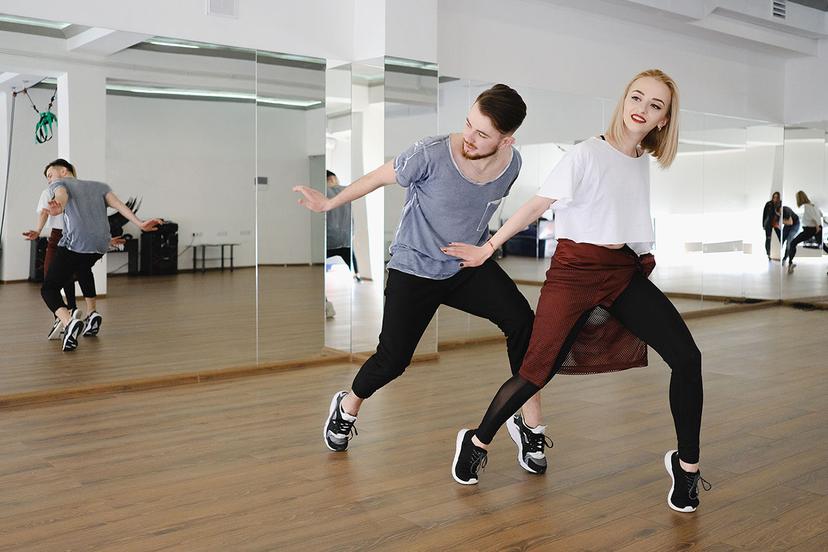Dance

Industry Outlook
The research group IBISWorld reported that in 2018, the dance studios industry generated $3.6 billion in revenue and that consumer spending on dance instruction had increased gradually since 2013. The U.S. Department of Labor (DOL) reports that the number of jobs for dancers will grow by only 1 percent through 2028, and those for choreographers will decline by 3 percent during the same timeframe. Interest in traditional dance has been declining, and there is increased interest in popular dance, which will lead to a rise in registration at dance schools and the need for choreographers.
The employment picture is clouded by fierce competition and too few available positions. Typically, performers make ends meet by branching out. They find short-term jobs in television or industrial revues. During the summer they try to find work with a stock company at a resort or with a musical road company.
According to IBISWorld, the dance studio industry included nearly 47,000 businesses during the late 2010s, collectively employing almost 96,300 people. The DOL provided insight regarding the top employers for dancers and choreographers. Among dancers, 30 percent were self-employed in 2018. Another 27 percent worked for performing arts companies. Educational services employed just 9 percent of dancers, followed by spectator sports at 6 percent. About 48 percent of choreographers worked for state, local, and private educational services. Another 30 percent of choreographers were self-employed, and 16 percent worked for performing arts companies.
Relying as it does on people gathering together for lessons and rehearsals, audiences in the theater and a troupe on stage or in a studio, the dance industry suffered many setbacks and delays during the 2020 COVID-19 pandemic. Lincoln Center in New York City shut down and the American Ballet Theater cancelled a tour. Perhaps most emblematic of how the outbreak affected dancers was the total shutdown of Broadway in New York City as of the spring of 2020. Across the country, many dancers and related workers found themselves unemployed and venues closed for the duration of the pandemic due to lockdowns and social distancing requirements. It remained to be seen what long-term changes the industry might undergo. One possible change down the road may be the decentralization of the dance industry, with dancers moving to smaller towns due to the high cost of living and working in major cities such as New York. Some professional dancers have already left major cities and relocated to smaller communities during the pandemic. As described in a Dance Magazine article, "A more optimistic possibility is that dancers could move to their hometowns and nurture their local communities instead of solely focusing on major cities and touring."
According to a StudioDirector.com article, the dance studio industry had grown by 3 percent from 2015 to 2020. During the pandemic, dance performances have been staged outside, weather permitting, and many dancers have also shared their performances online and through social media sites such as Instagram, YouTube, and TikTok. As the COVID-19 vaccine achieves wider distribution in 2021 and the pandemic becomes contained, theaters will reopen and the dance industry will start to recover. One trend that is expected to grow post pandemic, however, is dance studios offering a hybrid of online as well as in-person classes, and dancers and dance companies continuing to have an online presence.
Location, Location, Location
People wishing to become part of the professional dance industry may need to locate in metropolitan areas, since most professional dance companies are located in these regions. Most small towns or rural areas do not have the number of people able to support professional organizations. In 2018, New York had the highest concentration of dancers (1,800), according to the DOL. California ranked second, with 730. Other leading states included Texas (720), Nevada (670), and Hawaii (440). New York/New Jersey ranked first among top metropolitan areas, followed by Las Vegas. Other leading areas included Minneapolis-St. Paul, Honolulu, Chicago, Los Angeles, Denver, San Francisco, and Philadelphia.
A growing interest in popular dance in U.S. culture has led to an increased demand for dance schools, which is reflected in IBISWorld's report. This sector of the industry offers more options as far as locations go, since smaller cities with large rural areas can often support a dance school. Also, schools that teach children are also often supported in smaller cities.
Salaries Vary Widely
Although the dance profession as a whole can be seen as a glamorous one, most dancers' salaries are low. The lead dancers at large companies can earn much higher salaries than company members in smaller organizations. According to the DOL, the average hourly wage for dancers in 2018 was $16.31 ($33,925 annually), although the top earners averaged $40.08 per hour ($83,366 annually). Choreographers earn more than dancers, with an average hourly wage of $22.98 ($47,798 annually).
In 2018, the DOL ranked the top-paying industries (by hourly mean wage) for dancers as follows:
- Colleges, Universities, and Professional Schools ($31.42)
- Travel Arrangement and Reservation Services ($30.06)
- Other Schools and Instruction ($28.77)
- Elementary and Secondary Schools ($24.99)
- Independent Artists, Writers, and Performers ($22.14)
Additionally, the DOL also ranked the top-paying states in 2018:
- Nevada ($28.83)
- Massachusetts ($24.25)
- Florida ($23.63)
- District of Columbia ($22.85)
- California ($22.45)
The Society of Health and Physical Educators, formerly known as the American Alliance for Health, Physical Education, Recreation and Dance, noted in a research report that performers were paid for rehearsal time, choreography lab time, performance time, and often for any class time required.
